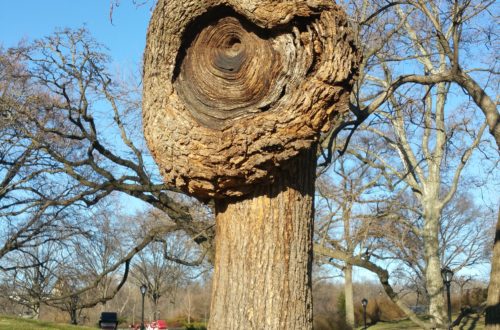
Smilax
After our recent move to Central Texas from the Northeast, we became reacquainted with the Smilax vine. It is not a happy friendship. The huge thickets of Smilax with their woody stems, thorny hooks and shiny leaves cover the barbed wire fence that borders our property. The vines climb into, over and around trees both small and large, engulfing them in an almost impenetrable cover. The smaller trees in their pathways often bend unnaturally towards the ground as the burden of the Smilax’s weight overwhelms them.
Any Texas gardener will tell you that Smilax vine is almost impossible to get rid of. A kind way to describe it is damage tolerant*—In other words, it comes back from severe pruning, being cut completely to the ground, or burning. Under the soil, the Smilax spreads through rhizomes, underground stems that mimic roots, which are capable of branching and spreading ad infinitum. My husband, the gardener in the family, fights a persistent but unwinnable battle with the Smilax that pops up all over our thin-soiled hillside. Smilax needs no fertilizer, loamy soil, frequent rain, or pruning. It flourishes in the most adverse conditions as it creates its own inexorable pathway in and around and through whatever is nearby.
Even while cussing, yanking, digging and chopping the stubborn invader, I have to admire the Smilax’s perseverance and tenacity. And if I look closely, I grudgingly admit that the waxy mottled-green leaves have a certain appeal. As I search online for more information on the Smilax, I discover that its strange name comes from a Greek myth. Smilax was a woodland nymph who was loved by a mortal named Crocus… It’s not hard to guess what happened. As often happens in those ancient stories, things didn’t end up in a happily-ever-after scenario for the couple. Some versions say that Smilax tired of Crocus’ love. Some say Crocus killed himself. All agree that the gods took pity on Crocus and turned him into a beautiful flower while transforming Smilax into the thorny vine. Ever afterward, the fragile, transient spring crocus as well as smilax’s heart-shaped leaves remind one of love’s beauty and endurance, as well as its potential for obsession and pain that could twine and grasp… and eventually strangle that which it surrounds.
In contrast to my own interpretation of the invasive pest, I am quite surprised to find out that there is a vastly different image of the Smilax vine. Several varieties (not our tough version) are actually cultivated and sold as greenery for weddings, parties, and other uses. Pictures of glossy dark Smilax vines twining around the bases of candelabras and over garden arches show the versatility of this plant, or at least the versatility of how people view it. I also discover that the dense thickets of wild Smilax provide protection and cover for small animals, food for birds and deer, and shelter during harsh winters. Apparently, the cursed Smilax of my own experience has virtue hidden among its prickly, sharp stems and mesh-like foliage.
I take another look at that pesky Smilax as I seek some connections to life and Spirit and energy. The ones about perseverance in the midst of inhospitable conditions seem a good place to start. Getting rid of Smilax is just not a realistic goal. At best it can be minimally controlled, and at worst, it can explode into a wild invasive tangle. Co-existence may be the best solution. In life, as in gardening, some things, many things in truth, simply cannot be eliminated. They are ever present. They can overpower and stunt growth and new life, or they can be shaped into garlands of prized greenery. These generalities are a mite clichéd, and I look for a more specific application of the Smilax to my own life. As I sit here writing at my desk in the predawn hours in this New Year of 2020, it suddenly becomes laughingly obvious where one firmly rooted, tenacious Smilax vine lives in me. A lifelong struggle with deeply entrenched insomnia greets me most every night. I have tried myriad remedies, both natural and manufactured: cool rooms, warm baths, soothing Apps, medicines, set routines and boring books. Even as a young child, I spent hours awake in the wee hours, singing and making up stories in my head, waiting for the first breaks of sunlight in order to justify getting up and starting my day. After many decades and countless hours awake in my quiet house, I know that there is no getting rid of this tangle. I may find relief for a while by exploring a newly discovered practice, adding a helpful food or eliminating late-night TV, but I will never truly be free of the wakefulness and accompanying whirring of my mind, which seems to rev up to full gear around 3 a.m. or so. A few years ago, I decided to stop fighting it, talking about it, complaining to others or seeking exotic remedies. Maybe it hasn’t turned into a soothing source of green beauty, this old smilax vine of wakefulness, but we do co-exist a bit more smoothly now. The old serenity prayer may be trite, but it is also true. Some things you can change. Some things you can’t. And some things you just need to learn to live with as peacefully as you can. I cannot quite bring myself to celebrate insomnia…yet, it does have those surprising heart-shaped leaves of solitude and peace alongside the sharp thorns and tangled branches of weariness. For it is not only insomnia that is persistent during those wee hours. I think of the middle of the night art work, the essays, the inspiration, the sudden clarity around a difficult decision that often emerge in those early morning times. I recall times of deep prayers and opportunities for contemplation and reassessment. I decide to turn to my watercolors, brushes and pens. At this hour, no phone calls or family demands will interrupt. As I paint and embellish, the Smilax emerges from the paper. The small painting reminds me that beauty accompanies the tenacity and stick-to-it-ive-ness of Smilax, and finds its way into the clinging habit of wakefulness as well.
I’m not about to give gardening advice to my husband as he chops and prunes the Smilax that is threatening the trees along the west side of our land. He can draw his own conclusions about perseverance and the value of maintaining some semblance of control over those things that invade and persist. Neither am I about to order some Smilax vines from those East Texas vendors who cultivate it and ship it for use in all sorts of festive occasions. I do, however, vow to look more closely at the heart-shaped leaves and the woody, thorny stems. They have a message about love in the midst of dry times and protection in the midst of harshness. They give lessons about how to set limits and how to welcome growth. They teach me about living with things that cannot or will not change, about endurance and patience, and about finding some measure of peace among the thorny places. Thankful for the Smilax vines in my live? That is still a stretch, but I sense some heart-shaped wisdom unfurling amidst those rough and stubborn places.
*Descriptions of Smilax vine are drawn from several websites, including Wikipedia, Greek Mythology, Texas Smilax and others.
Smilax Vine Original artwork by Beth Hatcher
Reflection Question:
Persistence and tenacity can both harm us and help us as we struggle with life’s challenges. How do you balance acceptance and hope, blessings and burdens, when faced with a Smilax vine in your life?





2 Comments
Penny Hood
What we resist, persists…. I don’t know if you were cursed with Bishops weed here in Maine…..
I love your painting, and I have the Serenity Prayer printed and on the wall where I can see it.
These are not small matters, and I thank you for sharing your thoughts…
Pen
Nita Gilger
I enjoyed this story anew and the art work is wonderful. So glad you included it!!